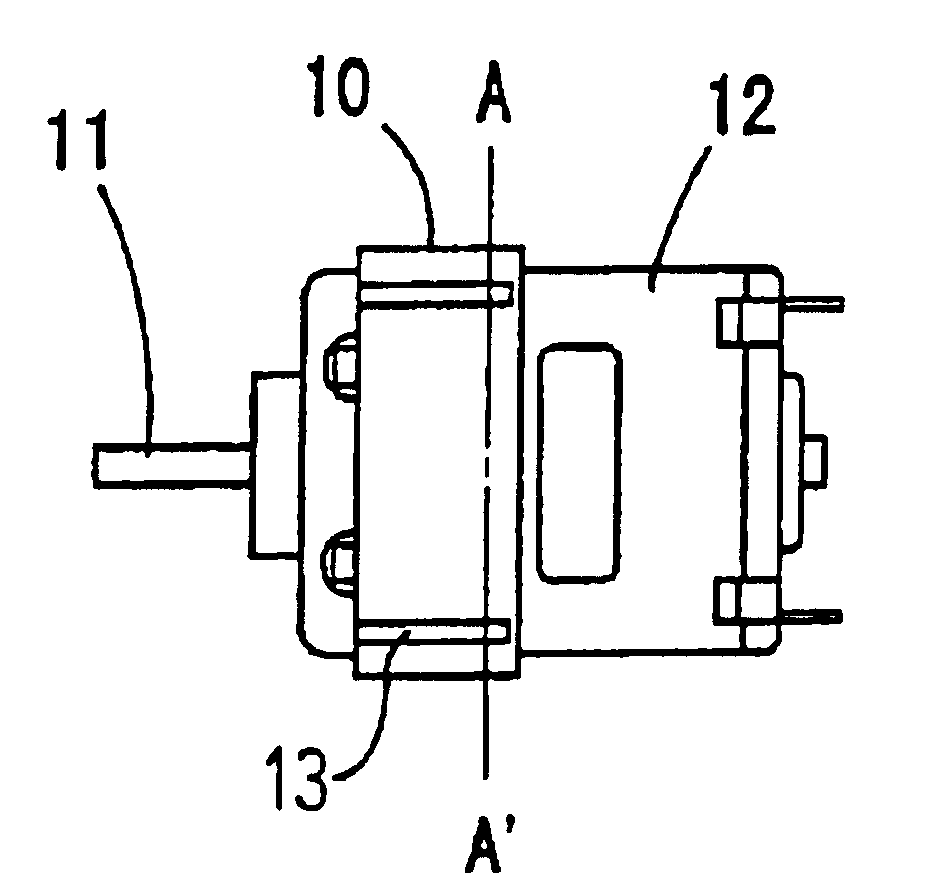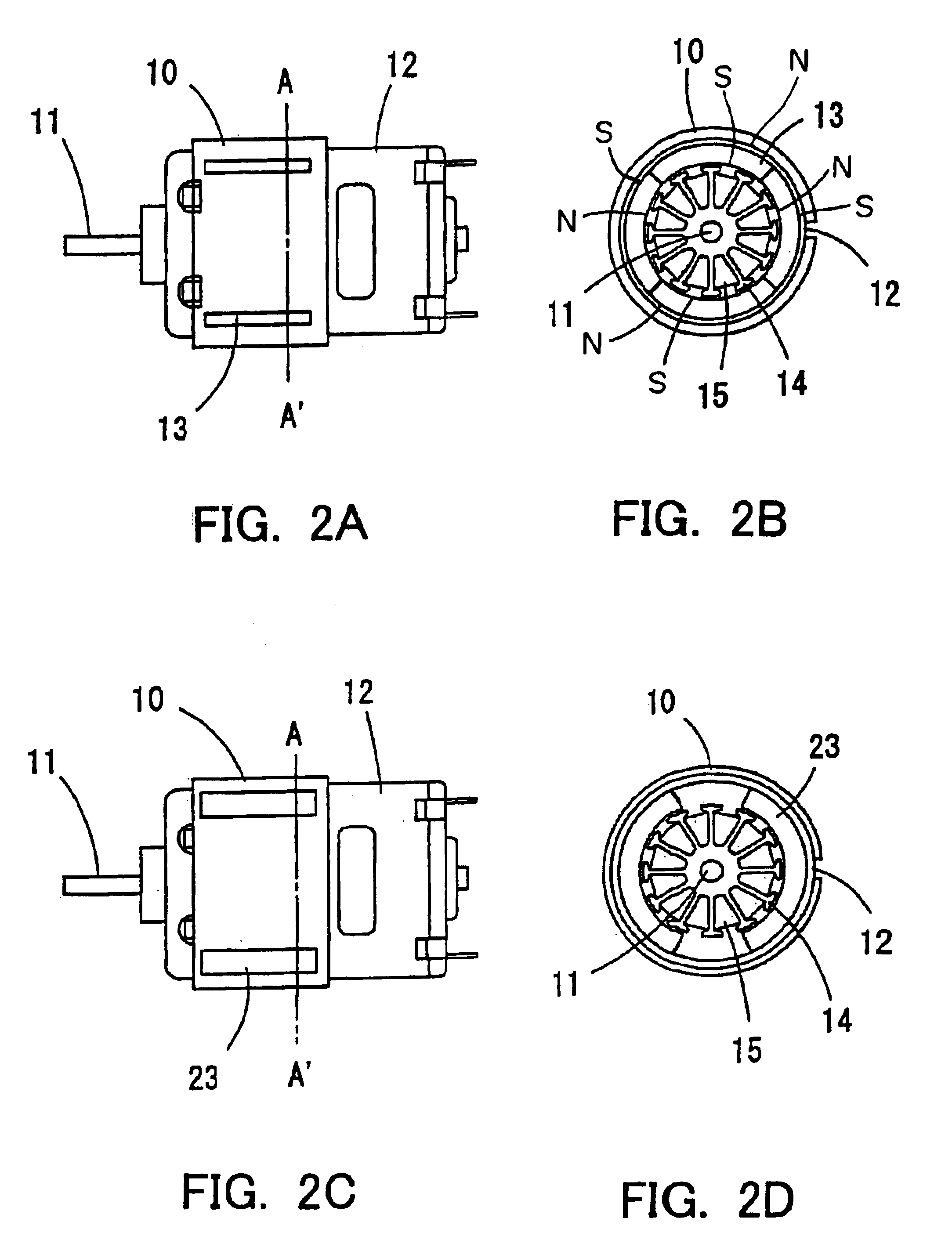DC brush motor and permanent magnet used therein
a brush motor and permanent magnet technology, applied in the direction of magnetic circuits, magnetic bodies, magnetic circuits characterised by magnetic materials, etc., can solve the problems of inability to realize high-output motors, inability to miniaturize such small-sized motors, and inability to achieve high-output motors. , to achieve the effect of improving the mechanical properties, reducing the volume of the motor, and reducing the size and weigh
- Summary
- Abstract
- Description
- Claims
- Application Information
AI Technical Summary
Benefits of technology
Problems solved by technology
Method used
Image
Examples
embodiment 1
(Embodiment 1)
[0061]FIGS. 1A and 1B shows an example motor of the present embodiment. This figure includes the side view 1A and the cross sectional view 1B through AA′. The purpose of the present embodiment is to make a smaller motor than the conventional motor. The motor of the present embodiment is comprised of a housing 12, an anisotropic rare earth bonded magnet 13 as the hollow cylinder permanent magnet set in the inner perimeter of the housing 12, an armature 14 making the electromagnetic rotor core set in the center, coils 15 wrapped around armature 14, a rotary shaft 11 extending from the center of armature 14, and a back yoke 10 that is a flux ring for prevention of magnetic flux leakage. The back yoke is a part of the housing. The motor housing and the back yoke have the same function as a magnetic circuit. Therefore In the present embodiment, the housing outer diameter as mentioned in the claims is the diameter of the back yoke. For a volume comparison, the conventional 2...
embodiment 2
(Embodiment 2)
[0078]Embodiment 1 was an example of the size reduction of the conventional motor by the use of an anisotropic rare earth bonded magnet. Using this anisotropic rare earth bonded magnet, with adjustment of radial thickness, it is possible to increase the motor torque. The present embodiment is an example of using an anisotropic rare earth bonded magnet to double the torque.
[0079]For example, the conventional motor using sintered ferrite magnet 23 has a torque of 75.7 (mN*m / A), a volume of approximately 56.1 cm3, which is to say a motor performance index T of T=1.35, and all other dimensions the same as those of the conventional motor explained in embodiment 1.
[0080]The motor of the present embodiment is shown in FIG. 2. In the present embodiment, the ratio of electromagnetic rotor core radius to housing outer diameter a / r is not less than 0.25 and not greater than 0.5, the ratio of housing thickness to magnet thickness w / d is not less than 1 and not greater than 4, and ...
embodiment 3
(Embodiment 3)
[0082]The motor of embodiment 1, which is a low output level DC brush motor of the present invention, is maintained with the following common-sense conditions (1) the ratio of electromagnetic rotor core radius to housing outer diameter a / r is not less than 0.25 and not greater than 0.5, and (2) the ratio of housing thickness to magnet thickness w / d is not less than 1 and not greater than 4, while the ratio of anisotropic rare earth bonded magnet 13 thickness to housing outer diameter d / r=R (hereafter referred to simply as ratio R) is changed and the motor performance index T is evaluated. The characteristics when anisotropic rare earth bonded magnet 13 has a maximum energy product of 14 MGOe are shown in FIG. 4. When ratio R is in the range not less than 0.01 and not greater than 0.10, the performance index T is greater than twice the performance index T of the conventional 2-pole ferrite motor (1.3). If the ratio R is less than the lower limit of 0.01, even with magne...
PUM
| Property | Measurement | Unit |
|---|---|---|
| volume | aaaaa | aaaaa |
| inner diameter | aaaaa | aaaaa |
| inner diameter | aaaaa | aaaaa |
Abstract
Description
Claims
Application Information
 Login to View More
Login to View More - R&D
- Intellectual Property
- Life Sciences
- Materials
- Tech Scout
- Unparalleled Data Quality
- Higher Quality Content
- 60% Fewer Hallucinations
Browse by: Latest US Patents, China's latest patents, Technical Efficacy Thesaurus, Application Domain, Technology Topic, Popular Technical Reports.
© 2025 PatSnap. All rights reserved.Legal|Privacy policy|Modern Slavery Act Transparency Statement|Sitemap|About US| Contact US: help@patsnap.com



